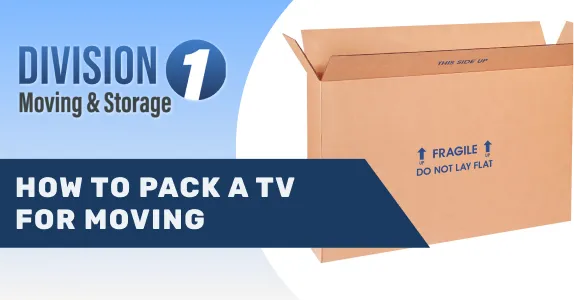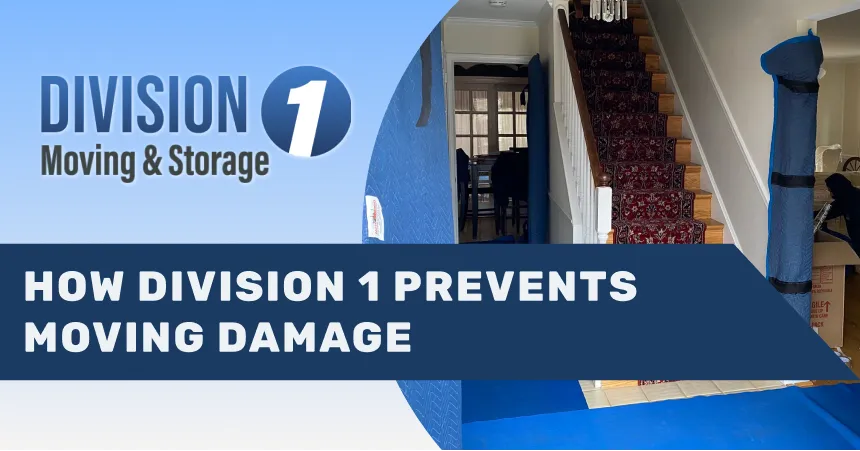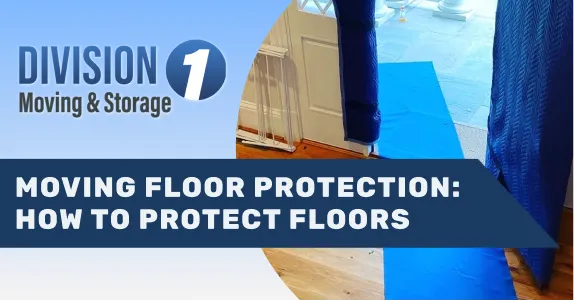The task of figuring out how to move a couch through a door can be overwhelming, often raising concerns about damaging your valuable furniture or the walls of your home. If you're facing the challenge of maneuvering a large couch through a tight doorway, know that you're not alone.
At Division 1 Moving, we specialize in turning the tricky process of how to move a couch through a door into a straightforward and worry-free experience. Our guide is crafted to lead you through each phase of the process, ensuring that your couch navigates through narrow doorways without a hitch.
Continue reading for practical and effective tips from Division 1 Moving on how to move a couch through a door. Our guide is filled with straightforward strategies and tips, designed to help you safely and efficiently move your furniture. Whether it's your first time handling such a task or you're looking to improve your approach, our guidance is here to make the process stress-free and successful.
Essential Materials for Moving a Couch
These materials not only ensure the safety of the couch but also simplify the moving process, making it more efficient and less stressful. The right tools can prevent damage to both the furniture and your home, and can even prevent personal injury.
Here's a rundown of the essential items you'll need, each chosen for its practicality and effectiveness in facilitating a smooth moving experience:
- Measuring Tape: An indispensable tool for ensuring your couch fits through the doorway. A precise measuring tape, like the Craftsman Self-Lock Tape Measure, allows you to compare the couch and doorway dimensions, avoiding any surprises during the move.
- Screwdriver: Essential for disassembling parts of the couch, such as removable legs. Options like the DEWALT DCF682N1 8V MAX Screwdriver offer efficiency and ease of use, making the disassembly process smooth and straightforward.
- Furniture Blankets: These provide protection against scratches and damage to your couch during the move. Recommended choices include the Sure-Max 12 Moving & Packing Blankets, which offer comprehensive protection and are easy to use.
- Moving Straps: Crucial for safely and easily lifting the couch. Straps like the Shoulder Dolly Moving Straps distribute the couch's weight, making it easier to maneuver through tight spaces.
- Gloves: Protect your hands and ensure a better grip during the move. Gloves such as the Gorilla Grip Maximum Grip All-Purpose Gloves are ideal for maintaining a secure hold on your couch.
Prepare to Move a Couch Through a Door in 5 Easy Steps
This step-by-step guide provides clear, actionable steps designed to make the task of moving a couch through a door much more manageable. By breaking down the process into distinct, easy-to-follow actions, it helps you prepare and execute the move efficiently, reducing the risk of damage to your furniture or property.

Step 1: Measure the Doorway
Begin by accurately measuring the doorway's height and width. It's essential to get precise measurements to ensure your couch can fit through. Once you have these numbers, compare them with the dimensions of your couch to assess whether it will pass through without issues.
Step 2: Remove Cushions
Then strip the couch of all cushions and pillows, lightening its weight and decreasing its bulk. This step simplifies the process of maneuvering the couch through tight spaces. Ensure the removed items are stored in a clean, secure area to prevent them from getting misplaced or damaged.
Step 3: Detach Couch Legs
If your couch has detachable legs, be sure to unscrew them. Removing the legs can provide additional clearance, which is especially helpful for taller couches. Keep the screws and legs in a clearly marked bag to avoid losing any parts.
Step 4: Remove the Door
In narrow spaces, taking the door off its hinges can create more room. Carefully use a screwdriver to remove the hinges and set the door and its hardware aside in a safe place. This step can significantly widen your working area, making the moving process smoother.
Step 5: Prepare the Room
Clear any obstacles on both sides of the doorway to ensure a hassle-free path for moving the couch. This might involve moving other pieces of furniture, rolling up rugs, or removing decorations that could impede movement or cause accidents. For added protection, consider placing moving blankets or furniture sliders on the floor and around other furniture items.
How to Safely Move Your Couch Through a Door: A Strategic Guide
Moving a couch through a door requires both strategy and precision. Here's a concise guide to help you select the most effective method, tailored to the specific dimensions of your couch and doorway, ensuring a smooth transition without damage.
- Vertical Move: Ideal for high ceilings and narrow doorways. This method involves standing the couch vertically, useful in scenarios where door width is limited. Watch this video to visualize how to move a couch vertically.
- Angled Approach: Perfect for extremely narrow doorways. This technique requires tilting and angling the couch, allowing it to maneuver through compact spaces. Read tips and techniques in Home Depot’s guide on how to move a couch.
- Disassembly and Reassembly: When all else fails, this method involves taking the couch apart and reassembling it in the new location. It's a more time-consuming but effective solution for tight spaces. Watch this video for a guide on disassembling and reassembling a couch.
- Straight Lift Method: The most straightforward approach, suitable when the couch fits easily through the door. This method minimizes potential damage by avoiding complex maneuvers. Learn more with this tutorial on the best ways to lift heavy furniture.
Tips for Disassembling and Reassembling a Couch
Disassembling and reassembling a couch can be a practical solution when moving it through tight spaces or doorways. This strategy requires patience, organization, and attention to detail. By following these steps, you can ensure that your couch is safely and effectively moved through tight spaces and reassembled to its original state.

Disassembling the Couch
Disassembling the couch involves taking apart its various components, such as cushions, legs, and sometimes the frame, to make it easier to move, especially through narrow spaces or doorways. This process requires careful handling and organization to ensure each part can be efficiently reassembled later.
- Check for Manufacturer’s Instructions: If available, refer to the manufacturer’s instructions for disassembly. This can provide specific guidance tailored to your couch model.
- Label and Organize Screws and Bolts: As you remove screws, bolts, and other fasteners, label them and store them in separate bags or containers. This organization will make reassembly much easier.
- Take Photos for Reference: As you disassemble the couch, take photos at each step. These images will serve as a helpful reference when you reassemble the couch.
- Carefully Detach Joined Sections: If your couch has multiple sections joined together, carefully detach them. Look for connectors or clamps that hold the sections together and gently release them.
- Handle the Frame with Care: Be gentle when handling the frame of the couch. Avoid forcing any parts apart, as this can cause damage.
Reassembling the Couch
Reassembling the couch entails putting back together its previously disassembled parts, such as legs, cushions, and frame, following its original structure to restore it to its full form and functionality.
- Refer to Your Photos and Notes: Before reassembling, look at the photos and notes you took during disassembly. This will refresh your memory on how the parts fit together.
- Start with the Frame: Begin by reassembling the frame of the couch. Ensure that all sections are aligned properly before securing them.
- Reattach the Legs and Armrests: Screw the legs, armrests, or any other detached parts back into place. Make sure they are tightened securely but avoid over-tightening, which can strip the threads or damage the wood.
- Replace Screws and Bolts: Using the labeled bags or containers, find the appropriate screws and bolts for each part of the couch and reattach them. The labels you made during disassembly will be invaluable here.
- Double-Check All Connections: After reassembly, go over the couch to double-check that all parts are securely fastened and that there are no loose components.
How to Properly Lift a Couch
Proper lifting techniques will ensure a successful and injury-free move. When it comes to moving heavy furniture like a couch, understanding and applying the right methods can significantly reduce strain and risk. Here's how to properly lift a couch:

Use Moving Straps
Moving straps are essential tools that redistribute the weight of the object, making it easier to carry heavy items like couches. They not only offer better control but also significantly reduce strain on your back and arms. For a visual guide on using moving straps effectively, check out this tutorial on using moving straps.
Lift with your Legs
One of the fundamental rules of lifting heavy objects is to use your legs, not your back. Lifting from the knees helps prevent back injuries, which are common during moves. For a comprehensive understanding of this technique, watch this instructional video on lifting heavy objects.
Pivot, Don’t Twist
When moving a couch, it's important to avoid twisting your body. Instead, pivot with your feet. This method involves turning your entire body in the direction you want to go, which helps prevent stress on your spine. Pivoting rather than twisting ensures that you don’t make any sudden or awkward movements that could lead to injury.
Engage Your Core
Engaging your core muscles provides stability and balance, helping to maintain a strong posture while lifting and moving the couch. By keeping your core muscles tight, you not only stabilize your body but also significantly reduce the risk of injury. This practice is especially important when navigating through tight spaces or adjusting the couch's position.
Additional Tips for to Safely Move a Couch
Moving heavy furniture like a couch is not just about muscle power. The right approach can make all the difference in a safe and efficient move. Here are additional tips that complement proper lifting techniques when navigating through tight spaces or dealing with bulky items.

Teamwork
Having a partner not only makes the lift easier but also provides stability and balance. It's much easier to manage the weight and size of a couch when the load is shared. A partner can help spot potential hazards and assist in maneuvering around obstacles, reducing the risk of accidents.
Communication
Establish clear communication with your lifting partner. Agree on simple, unambiguous commands to coordinate your movements. Effective communication ensures that both you and your partner move in harmony, which is essential for safely navigating through doorways, around corners, and across uneven surfaces.
Take Breaks
If the couch is heavy or the move is complex, taking short breaks can help manage physical strain. Fatigue can lead to a loss of grip strength and concentration, increasing the risk of accidents. Regular breaks allow you to stay alert and focused, ensuring that both you and the couch remain safe throughout the moving process.
Hire Professionals
When the task of moving heavy furniture like a couch appears too daunting or risky, it's wise to consider hiring professional movers. Professional movers have the training, experience, and equipment to handle heavy and bulky items safely.
Choosing Division 1 Moving to Assist in Your Move
When facing the challenge of moving large furniture like a couch through tight spaces, choosing the right moving company can make all the difference. Division 1 Moving stands out as a premier choice for several compelling reasons:
.webp)
Expertise and Experience
Division 1 Moving's team is not just skilled in moving furniture; they understand the nuances of navigating challenging spaces. With a history of successful moves, Division 1 Moving brings a wealth of experience to your moving situation. This experience means we're well-equipped to handle unexpected challenges that may arise during the move.
Customized Moving Solutions
Every move is unique, and Division 1 Moving recognizes this by offering customized solutions. Whether it's a single piece of furniture or an entire household, we adapt our services to meet your specific needs. We come equipped with the necessary tools and materials, such as furniture blankets, moving straps, and professional-grade equipment, ensuring your belongings are moved safely and efficiently.
Safety and Security
The safety of your furniture is a top priority. Division 1 Moving takes every precaution to prevent damage to your items and property, using protective materials and employing safe moving techniques. The movers at Division 1 Moving are not only trained in the physical aspects of moving but also in safety protocols, ensuring a risk-free move for both the team and your belongings.
Stress-Free Experience
By entrusting your move to Division 1 Moving, you save valuable time. Our efficiency and proficiency mean your move is completed faster, allowing you to focus on settling into your new space. Knowing that your move is in the hands of professionals provides peace of mind. With Division 1 Moving, you can relax, knowing that every aspect of the move is being handled expertly.
Customer-Centric Approach
Division 1 Moving prides itself on excellent customer service. We maintain clear and constant communication throughout the moving process, ensuring you are informed and comfortable every step of the way. The numerous satisfied customers and positive testimonials speak to the quality of service provided by Division 1 Moving.
Local Knowledge and Presence
With a strong presence in Virginia, Division 1 Moving has an in-depth understanding of the local areas, which can be crucial for navigating moves in specific neighborhoods or cities. As a locally established company, Division 1 Moving has built trust within the community, making us a reliable and respected choice for your moving needs.
%201.webp)

.webp)





























.webp)


